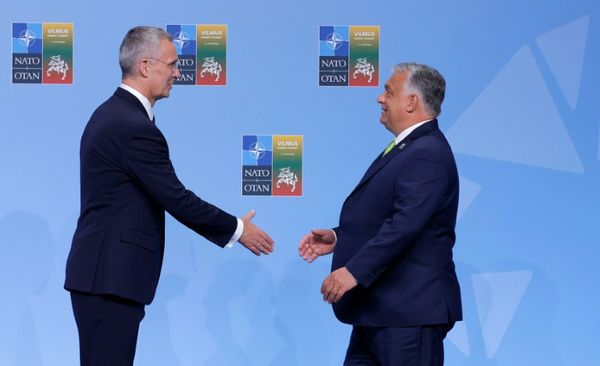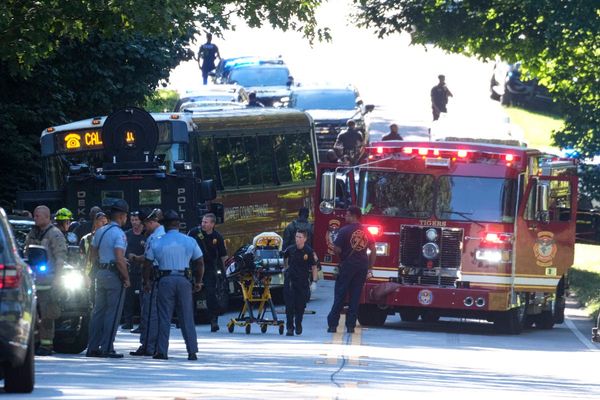
Formula 1's return to Las Vegas got off to a shockingly bad start with Ferrari's Carlos Sainz striking a loose water valve cover in FP1 and that session having to be abandoned after just eight minutes of running. What followed was a communications and optics horror show from both the race organiser, which is F1 itself, and FIA regulator.
But by the end of a very long working day in Sin City – taking in two, with track action having started at 8.30pm on Thursday night and ended at 4am on Friday morning – an extended practice session had taken place. But in front of no fans.
Things did look better for Ferrari come the action's end – even if it was still livid about Sainz's car being smashed, along with Esteban Ocon's Alpine, in the FP1 shambles. The Scuderia led the way on pure pace with its slippery SF-23 on this straight-heavy new course in FP2, but it looks to be very close so far with Red Bull on the long runs that eventually concluded the elongated session.
That and much more is included in this presentation of everything we learned in the first practice sessions for F1's return to Vegas after a 41-year absence.
The story of the day

FP1 lasted just eight minutes. Just as the drivers were building up to speed on the slippery new track surface and Charles Leclerc had gone quickest with a 1m40.909s, the red flags flew as Sainz had stopped in the other Ferrari halfway down the long blast across Las Vegas' famous Strip.
There was no further information on what had gone wrong for 11 minutes. Then a jaw-dropping message was displayed: The session would not be resumed.
Motorsport.com was watching trackside at the Turns 7/8 complex in front of the gigantic Sphere entertainment venue. There was stunned silence from the spectators in not-packed grandstands behind us. The circuit commentary team announced they could not provide any information for what was going on. People began to head for the exits. Reports of booing from the grandstand opposite the main straight soon began to appear.
News began to trickle out as the FIA's media team relayed information from race control. Sainz had struck a water valve cover that had been worked loose – smashing considerable parts of his SF-23.
After the session had been stopped a few moments later, Ocon then hit the valve too – damaging his floor so badly Alpine had to change his chassis
An analysis of the onboards of the cars in the vicinity of Strip's halfway point before Sainz struck the water valve – audibly shocked at the forces suddenly exerted on his body on his team radio immediately after the impact – suggests Ocon's car actually ran over the valve and dislodged it.
The following Pierre Gasly and Alexander Albon went through the now yellow-flagged zone without incident, before Aston Martin's Fernando Alonso jinked left at the point of the yellows, apparently to avoid what he had spotted on the road ahead. Sainz then arrived and struck the valve cover.
After the session had been stopped a few moments later, Ocon then hit the valve too – damaging his floor so badly Alpine had to change his chassis. Ferrari did likewise, with team boss Fred Vasseur revealing afterwards that the incident had "damaged completely the monocoque, the engine, the battery" Sainz had been using.
Vasseur was speaking in the team principals' press conference immediately after the cancelled session (always planned in the schedule, at 10pm). It was a feisty event, with the Ferrari team boss unable to hide his fury over the water valve incident.

Alongside him, Mercedes boss Toto Wolff also reacted angrily to being interrupted by a reporter heckling his statement that "they're going to seal the drain covers and nobody's going to talk about that tomorrow morning anymore". There followed a two-hour information vacuum.
Rumours swirled in the paddock that officials were working to get an extended but delayed FP2 session going. But it took until 00.30 local time for there to be anything concrete from the FIA or F1 on what was going on – bar a timing system message saying the start of FP2 would be delayed past its previously scheduled midnight commencement.
On the track, engineers and officials were working to inspect 30 water valves along the Strip. They then switched to filling them in with a mixture of asphalt and resin in an effort to get FP2 going. One Motorsport.com source has indicated that this only took place on the Strip as it was felt the lower speeds the drivers were reaching elsewhere meant the forces on the water valves and manhole covers typical of any street track were not high enough to force anything loose.
It was finally determined at 00.30 that, just as with Canada back in June and FP1 there being lost to that track's CCTV issue, a 90-minute FP2 session could indeed go ahead at 2am. Although, as this approached, it was pushed back by a further 30 minutes.
Alpine, meanwhile, announced that it had repaired Ocon's car in time for him to compete in FP2. Ferrari asked the stewards if it could replace the wrecked battery on Sainz's car without a penalty given the strange situation. But this was denied as, per an FIA bulletin, "Article 2.1 of the Formula 1 Sporting Regulations obliges all officials, including the Stewards, to apply the regulations as they are written".
The bulletin added, "Accordingly, the mandatory penalty specified under Article 28.3 of the Sporting Regulations must be applied". This means Sainz will face a 10-place grid drop for Saturday's race. He said of this that he "honestly cannot understand it" and thinks "an exemption to the rule should have been considered given what happened".
Sainz was however, also able to get out in another rapidly rebuilt car – via a complete chassis change and a new engine – and in the delayed FP2 session he shot to the head of the initial times with his very first flier.

The extended session was dominated by Ferrari – excelling on the long straights as it had done on home turf at the Italian GP with its 'Monza special' skinny rear wing package. Leclerc was also among the gaggle of drivers that set a benchmark time early in FP2, where the Red Bull drivers went alone of the frontrunners in using the mediums.
But even when Verstappen and Perez were switched onto the softs after 25-minutes had passed, they did not pull clear on the softer compound. For Ferrari, Leclerc in particular was able to pull a little bit extra out compared to the rest as more and more rubber was laid down and, as expected, the new track underwent a significant track evolution process.
Lewis Hamilton got amongst the leaders ahead of FP2's halfway point, after which, with the leaders in the pits, Fernando Alonso slotted into second for Aston Martin.
As the hour mark approached, Leclerc improved the benchmark time to what would prove to be the session's best – a 1m35.265s – after Sainz, Perez and Alfa Romeo's Valtteri Bottas had shuffled Verstappen down the order. He ended up sixth as Alonso moved ahead of Perez just before Leclerc's table-topping effort had gone in.
Leclerc in particular was able to pull a little bit extra out compared to the rest as more and more rubber was laid down and, as expected, the new track underwent a significant track evolution process
After this, the whole pack concentrated on the long runs that typically close FP2 – somewhat of a surprise given the session was taking place four-and-a-half hours after Saturday's race is scheduled to start. But predicted temperatures for that session are just a degree hotter than with what was logged in FP2.
Lando Norris ended up down in 11th in the times after reporting he was getting a "limp home" engine sensor message early in FP2. This was later attributed to a cooling issue McLaren had detected and he ran somewhat off-set to the rest for FP2's remainder.
There had been plenty of talk ahead of this event about tyre preparation – particularly for the fliers that got the headline times today and will do also tomorrow (technically with the midnight Saturday start time) in qualifying. The predicted cold conditions pointed to drivers having to do multiple prep laps to get their rubber in the right operating window.
But even with temperatures twice as high as some had expected here this time of year, Leclerc's session-topping time came at the end of a seven-lap stint in which he pushed twice (his first effort on his final new set of softs abandoned after he went wide through the first corner and backed off).

The times were getting ever quicker as the track grip level rose, with the tyres also warming through the stints the drivers were putting in. These varied from team to team in terms of when the quickest times were being produced, with Alonso's personal best coming in after a three-lap softs stint and Verstappen getting his in four.
The teams were able to put in 408 laps on the softs as the event rules were amended to mean the two tyre sets that usually must be handed back after FP1 could be released back to Pirelli after being used in FP2. This meant the teams could use all 13 tyres sets they had available at the start of the event to get the extra running in.
The lost FP1 running meant the quickest times logged in FP2 were approximately four seconds slower than the teams had been expected to reach based on the pre-event simulation running.
FP2 overall order
| Pos | Driver | Team | Time | Difference |
| 1 | Leclerc | Ferrari | 1m35.265s | |
| 2 | Alonso | Aston Martin | 1m35.793s | +0.528s |
| 3 | Perez | Red Bull | 1m36.085s | +0.820s |
| 4 | Bottas | Alfa Romeo | 1m36.129s | +0.864s |
| 5 | Hulkenberg | Haas | 1m36.489s | +1.224s |
| 6 | Hamilton | Mercedes | 1m36.663s | +1.398s |
| 7 | Albon | Williams | 1m36.688s | +1.423s |
| 8 | Norris | McLaren | 1m36.864s | +1.599s |
| 9 | Gasly | Alpine | 1m37.134s | +1.869s |
| 10 | Tsunoda | AlphaTauri | 1m37.412s | +2.147s |
How the long-run picture boosts Red Bull, but shows Ferrari is really in the hunt
Mercedes was the first team to switch to long runs in FP2, which gave it the chance to test both medium and soft tyres on high fuel. The Black Arrows team felt its car balance improved nicely as the track gripped up but, although Hamilton's 12-lap mediums stint put Mercedes ahead of Aston and McLaren in the long-run averages Motorsport.com has collated (1m40.579s versus 1m40.716s and 1m40.891s for the green and orange teams respectively), Red Bull and Ferrari led the way.

Red Bull is ahead because Verstappen's 11-lap run came in at an average of 1m39.511s, which compared to Sainz's 1m39.753s. That is a difference of just 0.242s and with Sainz having to contend with a rebuilt machine, albeit missing no more FP1 running and experience compared to his rivals because of the earlier cancellation.
At Red Bull, the team feels there is still much to learn about both potential race tyres – the mediums and hards – with Verstappen suggesting the mediums didn't hold up in the way he had been expecting. This may explain why he had a late off at Turn 5 and also had to have several outlier times removed to establish his average, in what was an unusually erratic log of times for the world champion.
Sainz's run was much more consistent, with the Singapore winner actually ending up quicker at the end of his stint for Ferrari than the start. This is likely to do with a reduction in the graining the teams were detecting as their long runs went on, thanks to the additional rubber going onto the track surface.
The graining is occurring because the low-downforce packages the long straights require here means the drivers are sliding a lot and this is hurting the tyre surfaces rather quickly. But it's an issue across the grid and one the teams had identified along with the tyre warm-up challenge as a particular focus for this event.
The graining is occurring because the low-downforce packages the long straights require here means the drivers are sliding a lot and this is hurting the tyre surfaces rather quickly
Ferrari left feeling it is "quite competitive" right now, per Leclerc, regarding its efforts on Friday. At Aston, Alonso reckoned one of the reasons he was one of many runners to go off at Turn 12 (Turns 5 and 14 were also hotspots for this) was because of losing tyre temperatures on the straights. Alonso, however, thinks this could boost overtaking chances for the race.
At McLaren, the message is that it currently doesn't expect to continue its fine recent podium run due to is ongoing aerodynamic inefficiency issues being exposed on another straights-dominated layout a la Monza. Norris felt "the grip was poor and it's easy to go through the tyres quite quickly, which is what we were doing".
The lack of hard tyre running on heavier tanks for the frontrunners is a sign that they want to save the white-walled rubber for the race strategies. But the massive track evolution factor being witnessed means Pirelli is not ruling out any compound from being available for the teams to use in the showpiece session. This is despite the soft seemingly only being good for qualifying.
As the track is now open to local traffic until Friday's later action begins, this is expected to reset the track considerably – a process that will take place again ahead of the race on Saturday night.
What they say

Charles Leclerc: "For now, we look quite competitive, but there is still a long way to go. We have a limited amount of time left to prepare for tomorrow, so we will work hard to keep this momentum."
Max Verstappen: "From what we learnt, it won't be super straightforward to pick the tyres for the race. The soft was good over one lap, but it was struggling quite a lot on the long run. Even the medium didn't perform as expected, so there's still a few things we have to look into to improve our degradation. I think we still look very good compared to the others, but there's more lap time and management to find."
Fernando Alonso: "We had a decent first day but we still need to work on a few things, as does everybody. Let's see tomorrow when we extract more potential from the car. I think it's going to be very tight in Qualifying and the race."
Lewis Hamilton: "The balance of the car wasn't too bad and on similar tyres, I don't feel that we're too far off compared to our competitors. It looks like everyone is suffering from graining and we were running out of tyres; I think everyone was in a similar boat."
Lando Norris: "I think we're a long way off where we've been the last few weekends, but probably where we expected. It's similar to where we were in Monza and other low downforce circuits. It's a struggle at the minute but I'm sure we can make progress into tomorrow."







